Ellsworth’s Cinema of Swords: More o’ Zorro
Zorro, like the Batman, who borrowed more than a little from the adventures of the masked hero, is a perennial; Hollywood always has another reboot percolating in pre-production somewhere, and occasionally one of these makes it to the screen and the black-clad outlaw rides again. Disney’s Zorro was the definitive version from the late Fifties until the Seventies, when alternative takes on the evergreen character began to appear once more. The legend of Zorro is sturdy, iconic, and can stand a lot of revision and still work quite well. This week let’s look at Guy Williams’ version for Disney, and then a couple of variations on the theme once the character began to emerge from Williams’ long shadow.
(Reminder: Zorro’s first appearance, by the hero’s creator, Johnston McCulley, is included in Your Editor’s Big Book of Swashbuckling Adventure anthology.)
Zorro, Season One
Rating: ****
Origin: USA, 1957
Director: Norman Foster, Charles Barton, et al.
Source: Disney DVDs
A year after the hit British production of The Adventures of Robin Hood conquers television, Disney replies with Zorro, out-swashbuckling even the outlaw of Sherwood Forest. Latin heartthrob Guy Williams (born Armando Catalano) is perfectly cast as Zorro/Diego de la Vega, supported by two gifted comic actors, Henry Calvin playing Sergeant Garcia and mime artist Gene Sheldon playing the voiceless Bernardo, Diego’s servant. The show is a successful mix of high adventure and low comedy, funny and suspenseful.
The series’ structure resembles the movie serials of the Thirties and Forties, with the season’s 39 episodes presented in three arcs of 13 episodes each. The first, the “Monastario” arc, shows Don Diego, newly returned from Spain, donning the cape and mask of Zorro to oppose the corrupt and arrogant Comandante Monastario. These episodes were edited into a feature film, The Sign of Zorro, and were covered under that title.
The second, or “Magistrado” arc, introduces a new villain, Magistrado Carlos Galindo (Vinton Hayworth), who has the new, honest comandante assassinated and then proceeds to misrule the pueblo of Los Angeles to some dark agenda of his own, causing strife and inciting unrest. Sergeant Garcia is elevated to the rank of Acting Comandante but must take his orders from the Magistrado, though he usually hates following them.
To Garcia’s relief, the Magistrado’s plots are repeatedly thwarted by Zorro, whom Garcia begins to regard as more ally than enemy. Zorro discovers that the Magistrado is himself taking orders from someone else, a mastermind known as the Eagle who sends messages by feathers that have been clipped in patterns to carry orders in code. Finally, another new and honest comandante arrives, so when Zorro exposes the Magistrado’s schemes, he is brought to justice.
The third, or “Eagle” arc, reveals the plans of the really, really angry villain responsible for all the trouble, the ambitious aristocrat José de Varga (Charles Korvin), who hides behind the name of the Eagle. With Spain distracted by revolt in Mexico, Varga’s plan is to foment rebellion in California, not to free its people from Spanish colonial domination, but to declare it as a kingdom with Varga as its king.
Worse than that, he then plans to sell his Kingdom of California to a foreign power, the bidders being agents from America and Russia. A single outlaw can’t defeat such a broad conspiracy (no, not even Zorro!), so Don Diego must surreptitiously work with his father Don Alejandro’s alliance of landowners to foil Varga’s plans.
These are good stories, well told, and though some episodes are padded with the gratuitous comic antics of Sergeant Garcia, he’s so lovable that he gets away with it. There’s an occasional inconsistency of tone that comes from having a rotating stable of writers and directors, but these incongruities are easily overlooked. However, one could wish for stronger and more prominent female characters, but we get at least one in Suzanne Lloyd as Raquel Toledano, the ambitious wife of an honest comandante who falls for the false promises of the Eagle. She has a wicked smile.
Zorro, Season Two
Rating: ***
Origin: USA, 1958
Directors: William Witney, et al.
Source: Disney DVDs
By the time of its second season, Zorro is a big hit, and Disney doesn’t tamper much with the elements that make the series successful. However, the 13-episode story arcs of the first season gradually go by the boards; the “Monterery” arc, the first thirteen eps of season two, is really three mini-arcs of four or five episodes each, and after it concludes the rest of the season is a mix of short arcs and single, standalone episodes. Fortunately, each arc, no matter how short, is handled by a single director, which maintains internal consistency of tone and approach.
For the first arc, ably directed by William Witney, the story is relocated up the coast to the pueblo of Monterey, not that you can tell the difference, since they use the same sets as for Los Angeles. The plots reprise themes from season one — a conspiracy of robbers employing secret information, false abuses of authority — but this time there’s no real mystery about who’s behind it. The main villain in the first episode is played by the formidable Lee Van Cleef, but he’s replaced by a phony Native American named Pablo who is frankly awful. At least Anna Maria Verdugo (Jolene Brand), Diego’s on again, off again romantic interest, is spicy and courageous.
At the end of the “Monterey” arc, Diego’s father, Don Alejandro (George J. Lewis), learns that his son is the wanted fugitive Zorro… and turns out to be all right with that. This removes one of the sources of tension from the situation, which eases the series’ transition from a Western swashbuckler to a sort of outlaw situation comedy with bandit interludes. If anything, this only made the show even more popular, so Disney apparently knew what they were doing, though most of us will miss the edge of the earlier episodes.
The latter part of season two features more gags, more songs, and considerably less lethal combat than before: villains are more likely to be put in the stocks and humiliated than shot or run through. And the cast begins to feature higher-wattage and more recognizable guest stars, which doesn’t hurt, as that challenges Guy Williams (Zorro) to put more oomph into his performance to measure up.
Episodes 16 to 19, known as “The Gay Caballero” arc, feature Cesar Romero as Don Alejandro’s cousin, a charming rascal come to town to try to bamboozle Margarita (Hollywood leading lady Patricia Medina) into letting him marry her for her land and money. Even better are episodes 27 to 30, “The Man from Spain,” with the wicked Everett Sloane in temporary command of Los Angeles. Both these arcs were directed a man with the resounding name of Hollingsworth Morse, who had a firm grasp of TV light adventure — he went on to direct 62 episodes of Lassie, which should tell you pretty much all you need to know.
One of the keys to this series’ success, often overlooked, is the music by William Lava. In the Thirties, the Disney animation studio had perfected the art of syncing the musical soundtrack with the onscreen action, and their mastery of this technique was carried over into the live-action Zorro, with near-continuous mood-setting melodies punctuated by stings and small fanfares that bring every scene alive. No one else at the time could match it.
Zorro (1975)
Rating: ***
Origin: Italy/France, 1975
Director: Duccio Tessari
Source: 101 Films Blu-ray
Alain Delon enjoyed starring in The Black Tulip (1964) so much that he decided he wanted to make another swashbuckler, and hey, Zorro was available. Because it’s an Italian film shot in Spain, this is sometimes referred to as a Zorro Spaghetti Western, but it really isn’t, as it draws its inspiration far more from Disney’s Zorro TV series than from Sergio Leone.
Zorro gets an all-new origin that approximates the original but varies from it. In more-or-less 1820 in South America’s northern cordillera, Don Diego (Delon), on his way to Spain, meets an old friend traveling to the fictional province of Nuevo Aragón to take the reins as its new reformist governor. But he’s murdered by assassins, and though Don Diego kills them, his friend charges him to take his place in Nuevo Aragón — but he must give up killing. Diego reluctantly agrees.
Assuming the role of a feckless fop, Diego arrives in Nuevo Aragón as its new governor to find it grinding under the heel of the corrupt Colonel Huerta (Stanley Baker), who has the power of the military and the judiciary on his side. To fight on the behalf of the oppressed citizenry, Diego assumes the secret identity of Zorro, and the usual swashbuckling follows. A lot of this swashbuckling is played for laughs, and the slapstick gets pretty broad, especially after Huerta assigns the buffoonish Sergeant Garcia (Moustache — yes, that’s the actor’s name) to protect Governor Diego and track down Zorro. There are also various comic street urchins, comic annoying aristocrats, and a comic great dane dog. It’s pretty comic.
On the good side, the story has a competent heroine and sassy romantic interest for Zorro in Hortensia Pulido (Ottavia Piccolo), a steadfast opponent of Colonel Huerta, and the jailbreak scene in which Zorro rescues her from durance vile is pretty good. The long, acrobatic final duel between Zorro and Huerta is said to have been inspired by the final duel in Scaramouche (1952), a good idea since Alain Delon is a credible fencer, but unfortunately Stanley Baker is not, so the combat cuts awkwardly between close-ups of Baker and longshots of his fencing double.
In summary: a minor effort, pleasant enough but essential only for Zorro completists. Also, fair warning, it has an extremely obnoxious pop tune theme by Oliver Onions that is played far too often during action scenes. Turn it down!
George Hamilton in Zorro, The Gay Blade (1981)
Zorro, The Gay Blade
Rating: ***
Origin: USA, 1981
Director: Peter Medak
Source: Fox Home Entertainment DVD
After his comic turn in the vampire farce Love at First Bite (1979), dreamboat star George Hamilton went looking for another classic character to lampoon and decided on Zorro. The joke is, Zorro has a twin brother who is flamboyantly gay and stands in for him when he’s sidelined by an injury. Ha ha, right?
This film is dedicated to Rouben Mamoulian, who directed the classic 1940 Mark of Zorro, a scene of which is shown at the beginning of this movie to establish that it’s a direct sequel. It’s 1840, and Don Diego de la Vega (Hamilton), the son of the original hero, is in Madrid seducing married women when he receives a letter from his father summoning him back to California. By the time he reaches Los Angeles, his father has passed away, leaving behind his Zorro outfit and weaponry for Diego — or for his twin brother Ramón, as one of them must be fated to don the cape and mask at need.
And the need is immediate, for Los Angeles groans under the tyranny of Capitan Esteban (Ron Leibman), Diego’s childhood friend who has matured into a heartless despot. In youth they were rivals for the heart of Florinda (Brenda Vaccaro), who is now married to Esteban but who throws herself at Diego. However, Diego is smitten with the meddling Bostonian reformer Charlotte Taylor-Wilson (Lauren Hutton) and vows he will clean up Los Angeles as Zorro if only to win her love.
And so, after a long absence, Zorro reappears at the captain’s masked ball, where he crosses swords with Esteban, engages in a lot of classic athletic swashbuckling, and then falls out a window and injures his ankle. No more swashbuckling, just when L.A. needs Zorro the most!
Conveniently, Diego’s twin brother Ramón (also Hamilton) shows up to save the day, though instead of Spain he’s spent his life in Britain’s Royal Navy under the name Bunny Wigglesworth — in which role Hamilton delivers a spot-on impersonation of Percy Blakeney, the alter ego of the Scarlet Pimpernel, complete with “Sink me!” and peering through a quizzing glass. Diego persuades Ramón to take his place as the hero while his ankle heals, and he does, clad in a series of increasingly outrageous Zorro outfits in bright rainbow colors.
If this sounds funny, it mostly is, in the then-prevailing Mel Brooks mode of comedy, primarily due to the sheer enthusiasm with which Hamilton embraces the material — he was nominated for a Golden Globe for his performance. His co-stars aren’t up to his standard: Leibman as Esteban just shouts a lot and is tiresome, Brenda Vaccaro really wants to be Madeline Kahn but flops at it, and Hutton is vapid and shallow. Director Medak is good with the character scenes but doesn’t know how to shoot action, and the swordplay is undistinguished. However, it was filmed in Mexico and looks authentic to place and period, and no movie that lists a “Whip Tutor” in its credits can be all bad. Right?
Where can I watch these movies? I’m glad you asked! Many movies and TV shows are available on disk in DVD or Blu-ray formats, but nowadays we live in a new world of streaming services, more every month it seems. However, it can be hard to find what content will stream in your location, since the market is evolving and global services are a patchwork quilt of rights and availability. I recommend JustWatch.com, a search engine that scans streaming services to find the title of your choice. Give it a try. And if you have a better alternative, let us know.
Previous installments in the Cinema of Swords include:
Warmongers
Fables and Fairy Tales
Goofballs in Harem Pants, Part 2
Timey-Wimey Swordy-Boardy
Boy-Toys of Troy
Piracy – Two Wrecks and a Prize Ship
Postwar in the Greenwood
The Barbarian Boom, Part 4
Blood-Red and Blind: The Crimson Bat
Updating the Classics
Sink Me! Scarlet Pimpernels!
The Barbarian Boom, Part 5
Alexandre/Alexander
Musashi and Kojiro
Forgotten Fantasies
LAWRENCE ELLSWORTH is deep in his current mega-project, editing and translating new, contemporary English editions of all the works in Alexandre Dumas’s Musketeers Cycle, with the fifth volume, Between Two Kings, available now from Pegasus Books in the US and UK. His website is Swashbucklingadventure.net.
Ellsworth’s secret identity is game designer LAWRENCE SCHICK, who’s been designing role-playing games since the 1970s. He now lives in Dublin, Ireland, where he’s writing Dungeons & Dragons scenarios for Larian Studios’ Baldur’s Gate 3.
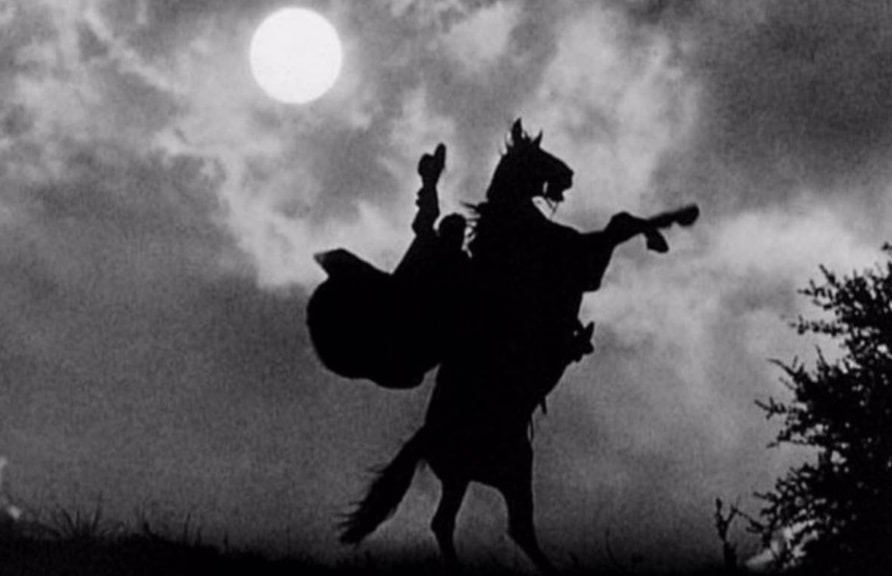
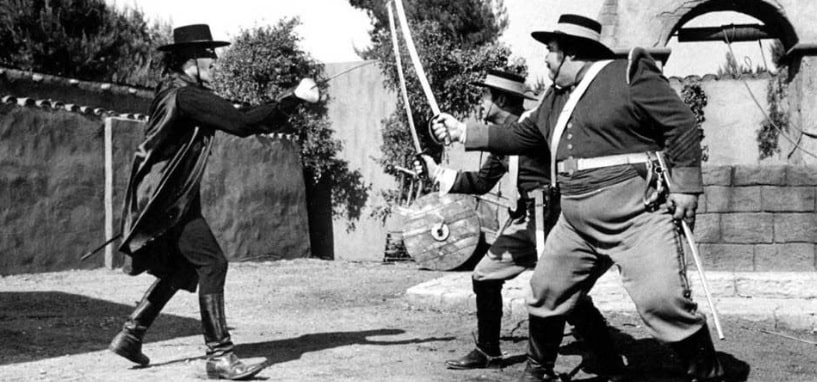
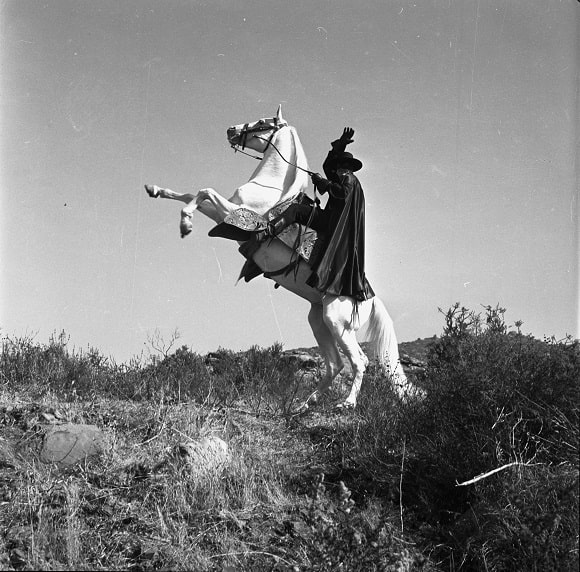
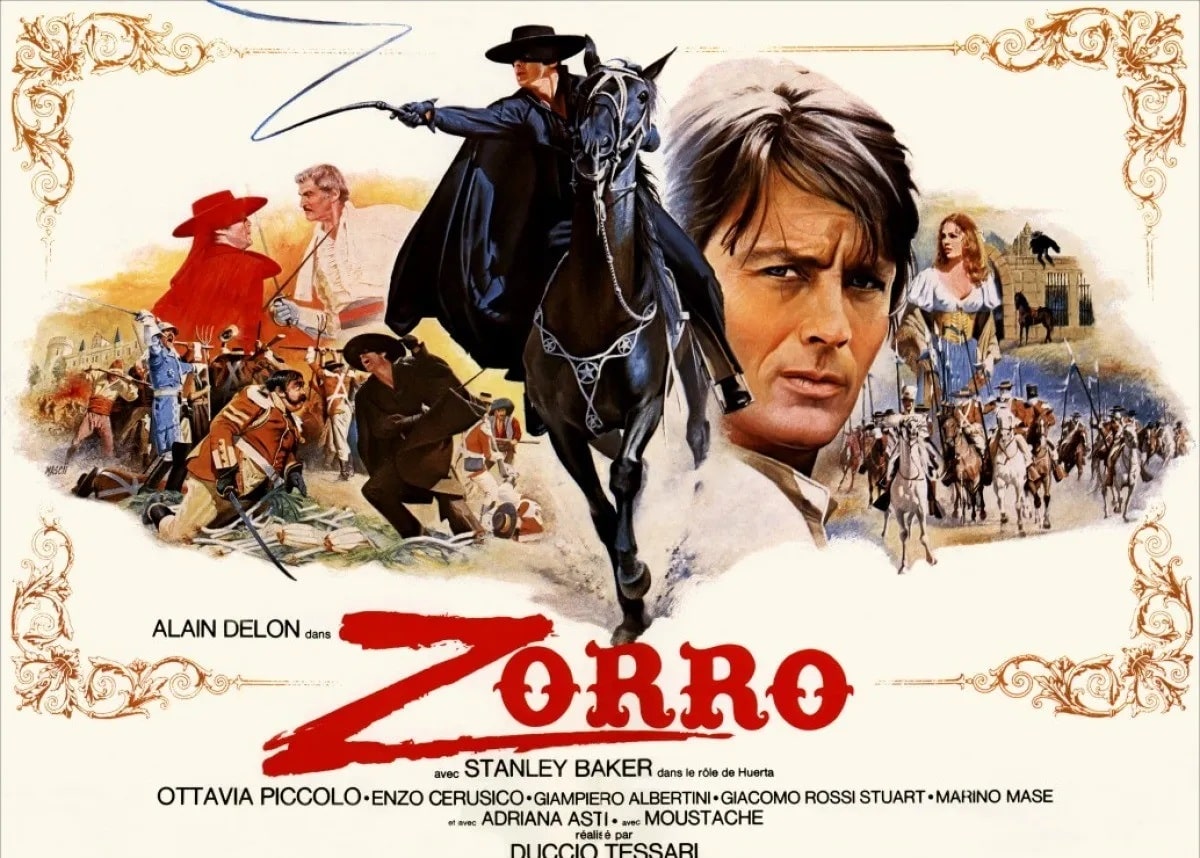
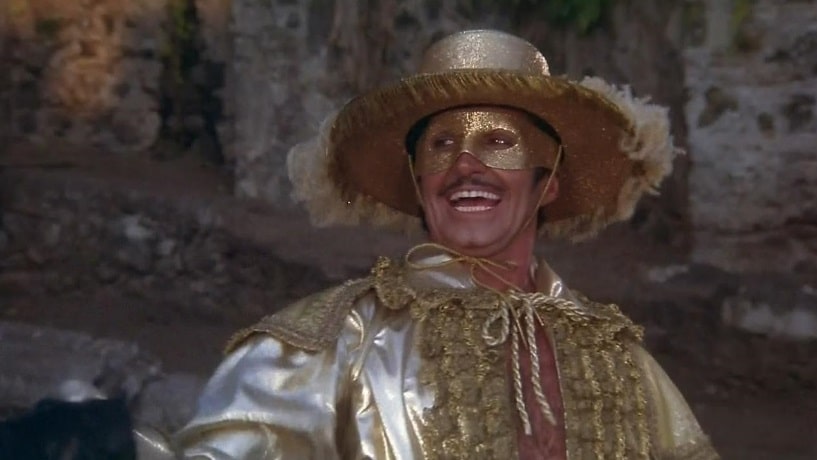
I remember watching the Zorro tv series as a kid when it was on the Disney channel.
Ah “Zorro, The Gay Blade” – such a fun movie that never pretended to be more than it was and revelled in it. The primary-colour Zorro costumes, the wink-wink dialogue, George Hamilton showing that he really was a decent actor….. Happy memories indeed.
I think Disney’s “Zorro!” was on ABC when I was a kid. There were some other great Disney shows that I guess we’d have called ‘miniseries’ if that word/concept had existed in the late ’50s. My favorites included “Texas John Slaughter,” “The Nine Lives of Elfego Baca,” and “The Saga of Andy Burnett.” I haven’t seen any of these in over 60 years now, and I rarely see anyone mention them.
“Si, it is the number two…”
“No!! It is a Z, for ZORRO!”
Gets me every time.
I remember watching the Disney Zorro with my parents, who had seen it as kids when it was new. We all enjoyed Zorro: The Gay Blade. I had a student once who accidentally told me more about himself than he knew when he gave me an email address that included bunny.wigglesworth. But my favorite Zorro take of all time is from the kids’s show The Backyardigans.
It’s an animated series in which five kids whose backyards adjoin do elaborate pretend play that matches some pop culture trope with as unlikely a musical style as possible, with a five-song musical plot. You know how the best children’s television is written at multiple layers, at least one for children (maybe more for children of various ages), and at least one or two for adults (maybe more for adults of various generations)? The Backyardigans does that better than anyone else.
In the Zorro-inspired episode, “The Masked Retriever,” our hero is a librarian in 1840s California who “avenges” unreturned library books. The musical inspiration for the episode is Herb Alpert and the Tijuana Brass, instantly recognizable to anyone who remembers the 1970s. It is charming and hilarious, start to finish. Its IMDB entry: https://www.imdb.com/title/tt1308209/
Another Ellsworth’s Cinema of Swords? You can never have too much Zorro!
I’ve seen the Disney Zorro and the Gay Blade movies (and enjoyed them) but I’ve never seen Alain Delon’s Zorro. I’ll have to look it up but thank you VERY much for the warning about the obnoxious theme song in the sound track. I’ve been burned by dumb songs before.
I. Always been interested in Zorro, when it showed on TV 1957. I was hooked. I would buy books , toys and movies of Zorro. I’m so glad I found this site. I now have Zorro Exploits, got that today. It looks great I’ll start reading it tomorrow.
I’m looking forward to finding other Zorro items.